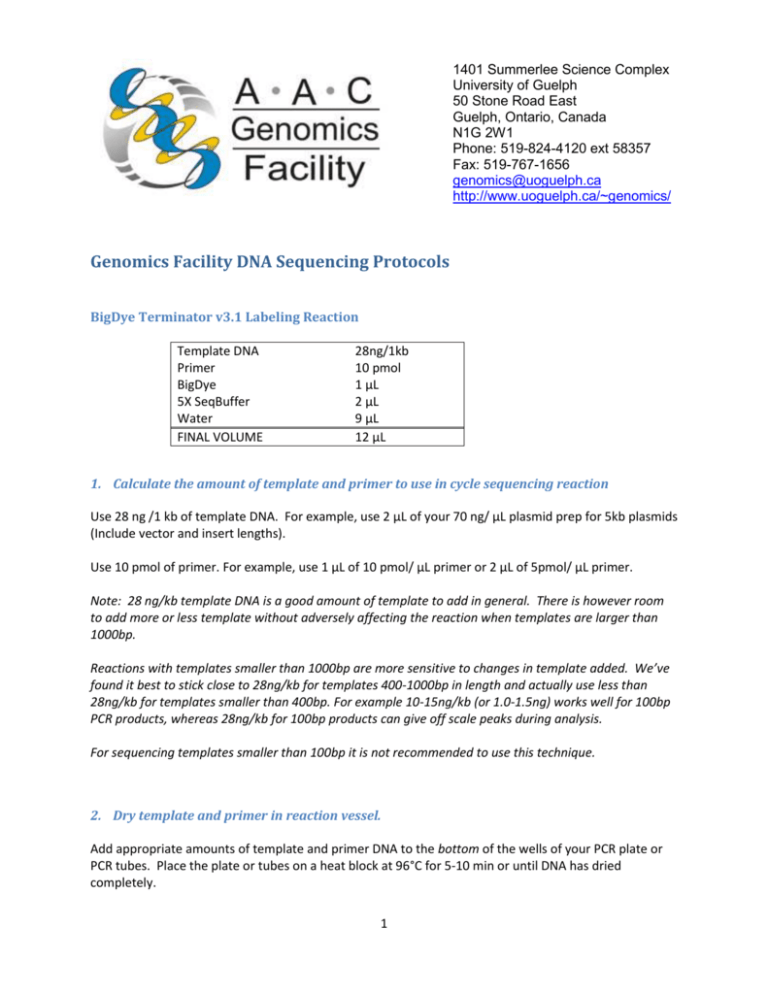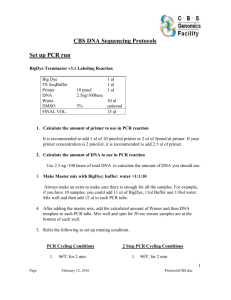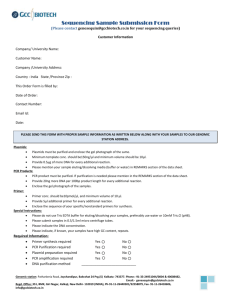Protocol for DNA sequencing
advertisement

1401 Summerlee Science Complex University of Guelph 50 Stone Road East Guelph, Ontario, Canada N1G 2W1 Phone: 519-824-4120 ext 58357 Fax: 519-767-1656 genomics@uoguelph.ca http://www.uoguelph.ca/~genomics/ Genomics Facility DNA Sequencing Protocols BigDye Terminator v3.1 Labeling Reaction Template DNA Primer BigDye 5X SeqBuffer Water FINAL VOLUME 28ng/1kb 10 pmol 1 μL 2 μL 9 μL 12 μL 1. Calculate the amount of template and primer to use in cycle sequencing reaction Use 28 ng /1 kb of template DNA. For example, use 2 μL of your 70 ng/ μL plasmid prep for 5kb plasmids (Include vector and insert lengths). Use 10 pmol of primer. For example, use 1 μL of 10 pmol/ μL primer or 2 μL of 5pmol/ μL primer. Note: 28 ng/kb template DNA is a good amount of template to add in general. There is however room to add more or less template without adversely affecting the reaction when templates are larger than 1000bp. Reactions with templates smaller than 1000bp are more sensitive to changes in template added. We’ve found it best to stick close to 28ng/kb for templates 400-1000bp in length and actually use less than 28ng/kb for templates smaller than 400bp. For example 10-15ng/kb (or 1.0-1.5ng) works well for 100bp PCR products, whereas 28ng/kb for 100bp products can give off scale peaks during analysis. For sequencing templates smaller than 100bp it is not recommended to use this technique. 2. Dry template and primer in reaction vessel. Add appropriate amounts of template and primer DNA to the bottom of the wells of your PCR plate or PCR tubes. Place the plate or tubes on a heat block at 96°C for 5-10 min or until DNA has dried completely. 1 Note: If using the same primer for a large number of reactions, you may prefer to add it to the master mix instead of drying it in the reaction vessel. In this case reduce the volume of water used in the master mix in Step 3 by the volume primer being added. 3. Make master mix with BigDye: buffer: water =1:2:9 Always make extra to make sure there is enough for all the samples. For example, if you have 10 samples, you could add 11 μL of BigDye, 22 μL Buffer and 99 μL water. Mix well. Note: For facility use I make master mix in bulk and freeze the excess for later use. ABI advises against this, but I haven’t had any problems keeping the mix for more than a week. Note: This amount of BigDye can be considered overkill for most types of templates. In most cases less BigDye can be used with no adverse effects. In a core facility setting however this ratio works well because of the range in template quality that we see. Generally, more BigDye in a reaction gives higher and sometimes cleaner signal at a higher cost. 4. Add master mix to DNA and prepare for thermocycling Add 12 μL of master mix to each tube/well. Close the tubes or seal the plates and vortex thoroughly to resuspend the DNA. Centrifuge briefly to bring the reactions to the bottom of the tube/well. 5. Thermocycle Cycling Conditions for Cycle Sequencing Reactions 1. 960C for 2 min 2. 960C for 30 sec. 3. 4. 45 - 600C for 15 sec.* 600C for 4 min 5. Goto step 2, 29X 6. Soak at 100C 0C 7. End. *Annealing temperature should be 3-100C below the Tm of the primer. Primers which require annealing temperatures below 450C often do not work well for cycle sequencing. Annealing at a temperature greater than 600C is not useful because extension takes place at 600C. 1401 Summerlee Science Complex University of Guelph 50 Stone Road East Guelph, Ontario, Canada N1G 2W1 Phone: 519-824-4120 ext 58357 Fax: 519-767-1656 genomics@uoguelph.ca http://www.uoguelph.ca/~genomics/ Preparation of Sephadex Columns (Completed by Facility) Make Sephadex plates using column loader and hydrate with 300ul water. Wait for 2-3 hours for columns to stabilize. If using stored Sephadex plates, take plate out of the fridge at least one hour before use. Sephadex plates can be stored in fridge for no more than one week. Signal strength will weaken if plate is more than two days old. Purification of Cycle Sequencing Reaction (Completed by Facility) 1. Remove reactions from the thermocycler. 2. Add 5 μL 1.6% (w/v) SDS solution to each reaction. Centrifuge to collect and place on 96°C heat block for 5 min. 3. Assemble a room temperature Sephadex plate with an empty collection plate and metal adaptor frame. Centrifuge at 750 x g (1900 RPM on the Allegra) for 5 minutes to dehydrate the columns. 4. Load 20 μL water into each well of a fresh MicroAmp plate, and assemble with the metal adaptor frame beneathe the dehydrated Sephadex plate. 5. Transfer each SDS-treated sequencing reaction to the centre of a Sephadex column and centrifuge the assembly at 750xg for 5 minutes. 6. Discard used Sephadex columns but save filter plate for washing. 7. Samples are now ready for electophoresis. 3








